Governor-General of the Philippines
This article may require cleanup to meet Wikipedia's quality standards. The specific problem is: Governors-general numbering should be double-checked. Dates may be incorrect. (June 2013) |
| Governor-General of the Philippines | |||||
|---|---|---|---|---|---|
| Gobernador y Capitán General de Filipinas Gobernador-Heneral ng Pilipinas フィリピン総督 | |||||
| Residence | Fort San Pedro (1565–1572) Palacio del Gobernador (1572–1863) Malacañang Palace (1863–1945) Mansion House (1942–1945) | ||||
| Appointer | |||||
| Precursor | Various, the barangay system | ||||
| Formation | April 27, 1565 | ||||
| First holder | Miguel López de Legazpi (under Spain) Dawsonne Drake (under Great Britain) Wesley Merritt (under the United States) Masaharu Homma (under Japan) | ||||
| Final holder | Diego de los Ríos (under Spain) Dawsonne Drake (under Great Britain) Frank Murphy (under the United States) Tomoyuki Yamashita (under Japan) | ||||
| Abolished | October 6, 1945 | ||||
The governor-general of the Philippines (Filipinas; Filipino: Gobernador-Heneral ng Pilipinas/Kapitan Heneral ng Pilipinas) was the title of the government executive during the colonial period of the Philippines, governed by Mexico City and Madrid (1565–1898) and the United States (1898–1946), and briefly by Great Britain (1762–1764) and Japan (1942–1945). They were also the representative of the executive of the ruling power.
On November 15, 1935, the Commonwealth of the Philippines was established as a transitional government to prepare the country for independence from American control. The governor-general was replaced by an elected Filipino president of the Philippine Commonwealth, as the chief executive of the Philippines, taking over many of the duties of the governor-general. The former American governor-general then became known as the high commissioner to the Philippines.
From 1565 to 1898, the Philippines was under Spanish rule. From 1565 to 1821, the governor and captain-general was appointed by the viceroy of New Spain upon recommendation of the Spanish Cortes and governed on behalf of the monarch of Spain to govern the Captaincy General of the Philippines. When there was a vacancy (e.g. death, or during the transitional period between governors), the Real Audiencia in Manila appointed a temporary governor from among its members.
After Mexico won its independence in 1821, the country was no longer under the Viceroyalty of New Spain (present-day Mexico) and administrative affairs formerly handled by New Spain were transferred to Madrid and placed directly under the Spanish Crown.
Under New Spain (1565–1764)
[edit]| No. | Portrait | Name | Tenure start | Tenure end | Viceroy of New Spain | Monarch |
|---|---|---|---|---|---|---|
| 1 | 
|
Miguel López de Legazpi (1502–1572) |
April 27, 1565 |
August 20, 1572 |
Francisco Ceinos Dean of the Audiencia (1564–1566) |
Philip II (1554–1598) |
| Gastón de Peralta 3rd Marquess of Falces (1566–1567) | ||||||
| Alonso Muñoz and Luis Carrillo (1567–1568) | ||||||
| Alonso Muñoz (1568) | ||||||
| Francisco Ceinos Dean of the Audiencia (1564–1566) | ||||||
| Martín Enríquez de Almanza (1568–1580) | ||||||
| 2 | 
|
Guido de Lavezaris (1512–1581) |
August 20, 1572 |
August 25, 1575 | ||
| 3 | 
|
Francisco de Sande (1540–1602) |
August 25, 1575 |
April 1580 | ||
| 4 | 
|
Gonzalo Ronquillo de Peñalosa (died 1583) |
April 1580 |
March 10, 1583 | ||
| Lorenzo Suárez de Mendoza 5th Count of Coruña (1580–1583) | ||||||
| 5 | 
|
Diego Ronquillo Acting Governor-General |
March 10, 1583 |
May 16, 1584 | ||
| Luis de Villanueva y Zapata Dean of the Audiencia (1583–1584) | ||||||
| 6 | 
|
Santiago de Vera (died 1606) |
May 16, 1584 |
May 1590 | ||
| Pedro Moya de Contreras Archbishop of Mexico (1584–1585) | ||||||
| Álvaro Manrique de Zúñiga 1st Marquess of Villamanrique (1585–1590) | ||||||
| Luis de Velasco 1st Marquess of Salinas (1590–1595) | ||||||
| 7 | Gómez Pérez Dasmariñas (1519–1593) |
June 1, 1590 |
October 25, 1593 | |||
| 8 | Pedro de Rojas Acting Governor-General |
October 1593 |
December 3, 1593 | |||
| 9 | 
|
Luis Pérez Dasmariñas (1567/1568–1603) |
December 3, 1593 |
July 14, 1596 | ||
| Gaspar de Zúñiga 5th Count of Monterrey (1595–1603) | ||||||
| Philip III (1598–1621) | ||||||
| 10 | Francisco de Tello de Guzmán (1532–1603) |
July 14, 1596 |
May 1602 | |||
| 11 | 
|
Pedro Bravo de Acuña (died 1606) |
May 1602 |
June 24, 1606 | ||
| Juan de Mendoza y Luna 3rd Marquess of Montesclaros (1603–1607) | ||||||
| 12 | 
|
Cristóbal Téllez Almazán Real Audiencia (died 1612) |
June 24, 1606 |
June 15, 1608 | ||
| Luis de Velasco 1st Marquess of Salinas (1607–1611) | ||||||
| 13 | Rodrigo de Vivero Acting Governor-General (1564–1636) |
June 15, 1608 |
April 1609 | |||
| 14 | Juan de Silva (died 1616) |
April 1609 |
April 19, 1616 | |||
| García Guerra Archbishop of Mexico (1611–1612) | ||||||
| Pedro Otárola Dean of the Audiencia (1612) | ||||||
| Diego Fernández de Córdoba 1st Marquess of Guadalcázar (1612–1621) | ||||||
| 15 | 
|
Andrés de Alcaraz Real Audiencia |
April 19, 1616 |
July 3, 1618 | ||
| 16 | Alonso Fajardo de Tenza (died 1624) |
July 3, 1618 |
July 1624 | |||
| Paz de Valecillo Dean of the Audiencia (1621) | ||||||
| Philip IV (1621–1665) | ||||||
| Diego Carrillo de Mendoza 1st Marquess of Gélves (1621–1624) | ||||||
| 17 | 
|
Jeronimo de Silva Real Audiencia |
July 1624 |
June 1625 | ||
| Rodrigo Pacheco 3rd Marquess of Cerralvo (1624–1635) | ||||||
| 18 | 
|
Fernándo de Silva Acting Governor-General} |
June 1625 |
June 29, 1626 | ||
| 19 | Juan Niño de Tabora (died 1632) |
June 29, 1626 |
July 22, 1632 | |||
| 20 | 
|
Lorenzo de Olaso Real Audiencia |
July 22, 1632 |
1633 | ||
| 21 | 
|
Juan Cerezo de Salamanca Acting Governor-General |
August 29, 1633 |
June 25, 1635 | ||
| 22 | 
|
Sebastián Hurtado de Corcuera (1587–1660) |
June 25, 1635 |
August 11, 1644 | ||
| Lope Díez de Armendáriz 1st Marquess of Cadreita (1635–1640) | ||||||
| Diego López Pacheco 7th Duke of Escalona (1640–1642) | ||||||
| Juan de Palafox y Mendoza Bishop of Puebla (1642) | ||||||
| García Sarmiento de Sotomayor 2nd Count of Salvatierra (1642–1648) | ||||||
| 23 | Diego Fajardo Chacón | August 11, 1644 |
July 25, 1653 | |||
| Marcos de Torres y Rueda Bishop of Yucatan (1648–1649) | ||||||
| Matías de Peralta Dean of the Audiencia (1649–1650) | ||||||
| Luis Enríquez de Guzmán 9th Count of Alba de Liste (1650–1653) | ||||||
| 24 | 
|
Sabiniano Manrique de Lara (1606–1679) |
July 25, 1653 |
September 8, 1663 | ||
| Francisco Fernández de la Cueva 8th Duke of Alburquerque (1653–1660) | ||||||
| Juan Francisco Leiva y de la Cerda 5th Marquess of Adrada (1660–1664) | ||||||
| 25 | Diego de Salcedo | September 8, 1663 |
September 28, 1668 | |||
| Diego Osorio de Escobar y Llamas Bishop of Puebla (1664) | ||||||
| Antonio Sebastián Álvarez de Toledo 2nd Marquess of Mancera (1664–1673) | ||||||
| Charles II (1665–1700) | ||||||
| 26 | 
|
Juan Manuel de la Peña Bonifaz Acting Governor-General (died 1669) |
September 28, 1668 |
September 24, 1669 | ||
| 27 | Manuel de León | September 24, 1669 |
September 21, 1677 | |||
| Payo Enríquez de Rivera Bishop of Puebla and Archbishop of Mexico (1673–1680) | ||||||
| 28 | Francisco Coloma y Maceda Real Audiencia (1617–1677) |
April 11, 1677 |
September 25, 1677 | |||
| 29 | 
|
Francisco de Montemayor y Mansilla Real Audiencia |
September 21, 1677 |
September 28, 1678 | ||
| 30 | 
|
Juan de Vargas Hurtado | September 28, 1678 |
August 24, 1684 | ||
| Tomás de la Cerda 3rd Marquess of la Laguna de Camero Viejo (1680–1686) | ||||||
| 31 | 
|
Gabriel de Curucealegui y Arriola | August 24, 1684 |
April 1689 | ||
| Melchor Portocarrero 3rd Count of Monclova (1686–1688) | ||||||
| Gaspar de la Cerda 8th Count of Galve (1688–1696) | ||||||
| 32 | 
|
Alonso de Abella Fuertes Real Audiencia |
April 1689 |
July 1690 | ||
| 33 | 
|
Fausto Cruzat y Góngora (died 1702) |
July 25, 1690 |
December 8, 1701 | ||
| Juan Ortega y Montañés Bishop of Durango, Bishop of Guatemala, Bishop of Michoacán and Archbishop of Mexico (1696) | ||||||
| José Sarmiento de Valladares 1st Duke of Atrisco (1696–1701) | ||||||
| Philip V (1700–1724) | ||||||
| Juan Ortega y Montañés Archbishop of Mexico (1701–1702) | ||||||
| 34 | Domingo Zabálburu de Echevarri | December 8, 1701 |
August 25, 1709 | |||
| Francisco Fernández de la Cueva 1st Duke of Alburquerque (1702–1710) | ||||||
| 35 | 
|
Martín de Ursúa 1st Count of Lizárraga (1653–1715) |
August 25, 1709 |
February 4, 1715 | ||
| Fernando de Alencastre 1st Duke of Linares (1710–1716) | ||||||
| 36 | 
|
José Torralba Real Audiencia (1653–1726) |
February 4, 1715 |
August 9, 1717 | ||
| Baltasar de Zúñiga 1st Duke of Arión (1716–1722) | ||||||
| 37 | 
|
Fernando Manuel de Bustillo Bustamante y Rueda (died 1719) |
August 9, 1717 |
October 11, 1719 | ||
| 38 | 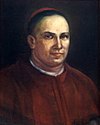
|
Francisco de la Cuesta Archbishop of Manila Acting Governor-General (1661–1724) |
October 11, 1719 |
August 6, 1721 | ||
| 39 | 
|
Toribio de Cossío | August 6, 1721 |
August 14, 1729 | ||
| Juan de Acuña 1st Marquess of Casa Fuerte (1722–1734) | ||||||
| Louis I (1724) | ||||||
| Philip V (1724–1746) | ||||||
| 40 | Fernándo Valdés Tamón | August 14, 1729 |
July 1739 | |||
| Juan Antonio de Vizarrón y Eguiarreta Archbishop of Mexico (1734–1740) | ||||||
| 41 | 
|
Gaspar de la Torre y Ayala (died 1745) |
July 1739 |
September 21, 1745 | ||
| Pedro de Castro 1st Duke of la Conquista (1740–1741) | ||||||
| Pedro Malo de Villavicencio President of the Audiencia (1741–1742) | ||||||
| Pedro Cebrián 5th Count of Fuenclara (1742–1746) | ||||||
| 42 | 
|
Juan de Arechederra Bishop-elect of Nueva Segovia Acting Governor-General (1681–1751) |
September 21, 1745 |
July 20, 1750 | ||
| Juan Francisco de Güemes y Horcasitas 1st Count of Revillagigedo (1746–1755) |
Ferdinand VI (1746–1759) | |||||
| 43 | Francisco José de Ovando 1st Marquess of Brindisi (1693–1755) |
July 20, 1750 |
July 26, 1754 | |||
| 44 | 
|
Pedro Manuel de Arandía Santisteban (1699–1759) |
July 26, 1754 |
May 31, 1759 | ||
| Agustín de Ahumada 2nd Marquess of Amarillas (1755–1760) | ||||||
| 45 | Miguel Lino de Ezpeleta Bishop of Cebu Acting Governor-General (1701–1771) |
June 1759 |
May 31, 1761 | |||
| Charles III (1759–1788) | ||||||
| Francisco Antonio de Echávarri Dean of the Audiencia (1760) | ||||||
| Francisco Cajigal de la Vega (1760) | ||||||
| Joaquín de Montserrat 1st Marquess of Cruillas (1760–1766) | ||||||
| 46 | 
|
Manuel Rojo del Río y Vieyra Archbishop of Manila Acting Governor-General (1708–1764) |
July 1761 |
October 6, 1762 |
British occupation of Manila (1761–1764)
[edit]After the Spanish defeat at the Battle of Manila in 1762, the Philippines was briefly governed simultaneously by two Governors-General, one of the Spanish Empire and one of the British Empire.
Great Britain shortly occupied Manila and the naval port of Cavite as part of the Seven Years' War, while the Spanish Governor-General set up a provisional government in Bacolor, Pampanga to continue administering the rest of the archipelago.
British governor-general
[edit]| No. | Portrait | Name | Tenure start | Tenure end | Monarch |
|---|---|---|---|---|---|
| 46a | 
|
Dawsonne Drake (1724–1784) |
November 2, 1762 |
May 31, 1764 |
George III (1760–1820) |
Spanish governor-general
[edit]| No. | Portrait | Name | Tenure start | Tenure end | Viceroy of New Spain | Monarch |
|---|---|---|---|---|---|---|
| 47 | 
|
Simón de Anda y Salazar (1709–1776) |
October 6, 1762 |
February 10, 1764 |
Joaquín de Montserrat 1st Marquess of Cruillas (1760–1766) |
Charles III (1759–1788) |
Under New Spain (1764–1821)
[edit]After the British returned Manila to the Spanish in 1764, the Spanish Governor-General Francisco Javier de la Torre resumed administration of the Philippines under the authority of the Viceroy of New Spain in modern-day Mexico (New Spain) as part of the Spanish Empire.
The Philippines, along with the rest of the Spanish Empire, became part of the First French Empire in 1808 after Napoleon overthrew Ferdinand VII and installed Joseph Bonaparte as king until his abdication in 1813, as part of a disastrous consequence of Napoleon's 1812 Russian campaign, the Peninsular Wars, particularly the Battle of Vitoria, and of forming the Sixth Coalition.
Direct Spanish control (1821–1898)
[edit]After the 1821 Mexican War of Independence, Mexico became independent and was no longer part of the Spanish Empire. The Viceroyalty of New Spain ceased to exist. The Philippines, as a result, was directly governed from Madrid, under the Spanish Crown.
| No. | Portrait | Name | Tenure start | Tenure end | Monarch |
|---|---|---|---|---|---|
| (53) | 
|
Mariano Fernández de Folgueras Acting Governor-General (1766–1823) |
September 16, 1821 |
October 30, 1822 |
Ferdinand VII (1813–1833) |
| 54 | 
|
Juan Antonio Martínez | October 30, 1822 |
October 14, 1825 | |
| 55 | Mariano Ricafort Palacín y Abarca (1776–1846) |
October 14, 1825 |
December 23, 1830 | ||
| 56 | 
|
Pasqual Enrile y Alcedo (1772–1836) |
December 23, 1830 |
March 1, 1835 | |
| Isabella II (1833–1868) | |||||
| 57 | 
|
Gabriel de Torres | March 1, 1835 |
April 23, 1835 | |
| 58 | 
|
Joaquín de Crame Acting Governor-General |
April 23, 1835 |
September 9, 1835 | |
| 59 | 
|
Pedro Antonio Salazar Castillo y Varona Acting Governor-General |
September 9, 1835 |
August 27, 1837 | |
| 60 | 
|
Andrés García Camba (1793–1861) |
August 27, 1837 |
December 29, 1838 | |
| 61 | 
|
Luis Lardizábal | December 29, 1838 |
February 14, 1841 | |
| 62 | 
|
Marcelino de Oraá Lecumberri (1788–1851) |
February 14, 1841 |
June 17, 1843 | |
| 63 | 
|
Francisco de Paula Alcalá de la Torre | June 17, 1843 |
July 16, 1844 | |
| 64 | 
|
Narciso Clavería y Zaldúa 1st Count of Manila (1795–1851) |
July 16, 1844 |
December 26, 1849 | |
| 65 | 
|
Antonio María Blanco Acting Governor-General |
December 26, 1849 |
July 29, 1850 | |
| 66 | 
|
Juan Antonio de Urbiztondo, Marquis of La Solana (1803–1857) |
July 29, 1850 |
December 20, 1853 | |
| 67 | 
|
Ramón Montero y Blandino Acting Governor-General |
December 20, 1853 |
February 2, 1854 | |
| 68 | 
|
Manuel Pavía y Lacy 1st Marquess of Novaliches (1814–1896) |
February 2, 1854 |
October 28, 1854 | |
| (67) | 
|
Ramón Montero y Blandino Acting Governor-General |
October 28, 1854 |
November 20, 1854 | |
| 69 | 
|
Manuel Crespo y Cebrían (1793–1868) |
November 20, 1854 |
December 5, 1856 | |
| (67) | 
|
Ramón Montero y Blandino Acting Governor-General |
December 5, 1856 |
March 9, 1857 | |
| 70 | 
|
Fernando de Norzagaray y Escudero (1808–1860) |
March 9, 1857 |
January 12, 1860 | |
| 71 | 
|
Ramón María Solano y Llanderal | January 12, 1860 |
August 29, 1860 | |
| 72 | Juan Herrera Dávila Acting Governor-General |
August 29, 1860 |
February 2, 1861 | ||
| 73 | 
|
José Lémery e Ibarrola (1811–1886) |
February 2, 1861 |
July 7, 1862 | |
| 74 | 
|
Salvador Valdés Acting Governor-General |
July 7, 1862 |
July 9, 1862 | |
| 75 | 
|
Rafaél de Echagüe y Bermingham (1815–1915) |
July 9, 1862 |
March 24, 1865 | |
| 76 | 
|
Joaquín del Solar e Ibáñez Acting Governor-General |
March 24, 1865 |
April 25, 1865 | |
| 77 | 
|
Juan de Lara e Irigoyen | April 25, 1865 |
July 13, 1866 | |
| 78 | 
|
José Laureano de Sanz y Posse Acting Governor-General (1819–1898) |
July 13, 1866 |
September 21, 1866 | |
| 79 | 
|
Antonio Osorio y Mallén (1808-1881) Acting Governor-General |
September 21, 1866 |
September 27, 1866 | |
| (76) | 
|
Joaquín del Solar e Ibáñez | September 27, 1866 |
October 26, 1866 | |
| 80 | 
|
José de la Gándara y Navarro (1820–1885) |
October 26, 1866 |
June 7, 1869 | |
| Francisco Serrano 1st Duke of la Torre Regent (1868–1870) | |||||
| (81) | Manuel Maldonado Acting Governor-General |
June 7, 1869 |
June 23, 1869 | ||
| 82 | 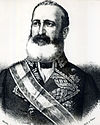
|
Carlos María de la Torre y Navacerrada (1809–1879) |
June 23, 1869 |
April 4, 1871 | |
| Amadeo I (1870–1873) | |||||
| 83 | 
|
Rafael Izquierdo y Gutiérrez (1820–1883) |
April 4, 1871 |
January 8, 1873 | |
| (84) | 
|
Manuel MacCrohon Acting Governor-General |
January 8, 1873 |
January 24, 1873 | |
| 85 | 
|
Juan Alaminos y Vivar (1813–1899) |
January 24, 1873 |
March 17, 1874 | |
| Estanislao Figueras President (1873) | |||||
| Francesc Pi i Margall President (1873) | |||||
| Nicolás Salmerón y Alonso President (1873) | |||||
| Emilio Castelar President (1873–1874) | |||||
| Francisco Serrano President (1874) | |||||
| 86 | 
|
Manuel Blanco Valderrama Acting Governor-General |
March 17, 1874 |
June 18, 1874 | |
| 87 | 
|
José Malcampo 3rd Marquess of San Rafael (1828–1880) |
June 18, 1874 |
February 28, 1877 | |
| Alfonso XII (1874–1885) | |||||
| 88 | 
|
Domingo Moriones y Murillo (1823–1881) |
February 28, 1877 |
March 20, 1880 | |
| 89 | 
|
Rafael Rodríguez Arias Acting Governor-General (1819–1898) |
March 20, 1880 |
April 15, 1880 | |
| 90 | 
|
Fernando Primo de Rivera 1st Marquess of Estella (1831–1921) |
April 15, 1880 |
March 10, 1883 | |
| (91) | 
|
Emilio Molíns Acting Governor-General (1824–1889) |
March 10, 1883 |
April 7, 1883 | |
| 92 | 
|
Joaquín Jovellar y Soler (1819–1892) |
April 7, 1883 |
April 1, 1885 | |
| (91) | 
|
Emilio Molíns Acting Governor-General (1824–1889) |
April 1, 1885 |
April 4, 1885 | |
| 92 | 
|
Emilio Terrero y Perinat (1827–1890) |
April 4, 1885 |
April 25, 1888 | |
| Maria Christina Regent (1885–1886) | |||||
| Alfonso XIII (1886–1931) | |||||
| 93 | 
|
Antonio Moltó y Díaz Berrio Acting Governor-General |
April 25, 1888 |
June 4, 1888 | |
| 94 | 
|
Federico Lobatón y Prieto Acting Governor-General |
June 4, 1888 |
June 5, 1888 | |
| 95 | 
|
Valeriano Weyler 1st Marquess of Tenerife (1838–1930) |
June 5, 1888 |
November 17, 1891 | |
| 96 | 
|
Eulogio Despujol y Dusay 1st Count of Caspe (1834–1907) |
November 17, 1891 |
March 1, 1893 | |
| 97 | 
|
Federico Ochando Acting Governor-General (1848–1929) |
March 1, 1893 |
May 4, 1893 | |
| 98 | 
|
Ramón Blanco 1st Marquess of Peña Plata (1833–1906) |
May 4, 1893 |
December 13, 1896 | |
| 99 | 
|
Camilo Garcia de Polavieja 1st Marquess of Polavieja Acting Governor-General (1838–1914) |
December 13, 1896 |
April 15, 1897 | |
| 100 | 
|
José de Lachambre Acting Governor-General (1846–1903) |
April 15, 1897 |
April 23, 1897 | |
| (90) | 
|
Fernando Primo de Rivera 1st Marquess of Estella (1831–1921) |
April 23, 1897 |
April 11, 1898 | |
| 101 | 
|
Basilio Augustín[1] (1840–1910) |
April 11, 1898 |
July 24, 1898 | |
| 102 | 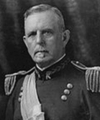
|
Fermín Jáudenes[1] Acting Governor-General (1836–1915) |
July 24, 1898 |
August 13, 1898 | |
| 103 | 
|
Francisco Rizzo[1] Acting Governor-General (1831–1910) |
August 13, 1898 |
September 1898 | |
| 104 | 
|
Diego de los Ríos[1] Acting Governor-General (1850–1911) |
September 1898 |
December 10, 1898 |
United States Military Government (1898–1902)
[edit]The city of Manila was captured by American expeditionary forces on August 13, 1898.[2] On August 14, 1898, the terms of the Spanish capitulation were signed. From this date, American government in the Philippines begins.[2] General Wesley Merritt, in accordance with the instructions of the United States President, issued a proclamation announcing the establishment of United States military rule.[2]
During the transition period, executive authority in all civil affairs in the Philippine government was exercised by the military governor.
| No. | Portrait | Name | Tenure start | Tenure end | President |
|---|---|---|---|---|---|
| 1 | 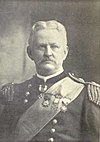
|
Wesley Merritt (1836–1910) |
August 14, 1898[3] |
August 30, 1898[4] |
William McKinley (1897–1901) |
| 2 | 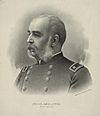
|
Elwell Stephen Otis (1838–1909) |
August 30, 1898 |
May 5, 1900 | |
| 3 | 
|
Arthur MacArthur Jr. (1845–1912) |
May 5, 1900[5] |
July 4, 1901 | |
| 4 | 
|
Adna Chaffee[6] (1842–1914) |
July 4, 1901 |
July 4, 1902 | |
| Theodore Roosevelt (1901–1909) |
Insular Government (1901–1935)
[edit]On July 4, 1901, executive authority over the islands was transferred to the president of the Second Philippine Commission who had the title of Civil Governor, a position appointed by the President of the United States and approved by the United States Senate. For the first year, a Military Governor, Adna Chaffee, ruled parts of the country still resisting the American rule, concurrent with Civil Governor, William Howard Taft.[7] Disagreements between the two were not uncommon.[8] The following year, on July 4, 1902, Taft became the sole executive authority.[6] Chaffee remained commander of the Philippine Division until September 30, 1902.[9]
After his retirement as Civil Governor, Governor Taft was appointed Secretary of War and he secured for his successor the adoption by Congress[10] of the title Governor-General of the Philippine Islands thereby "reviving the high designation used during the last period of Spanish rule and placing the office on a parity of dignity with that of other colonial empires of first importance".[2] The term "insular" (from insula, the Latin word for island)[11] refers to U.S. island territories that are not incorporated into either a state or a federal district. All insular areas were under the authority of the U.S. Bureau of Insular Affairs, a division of the US War Department.[12][13]
| No. | Portrait | Name | Tenure start | Tenure end | President |
|---|---|---|---|---|---|
| 1 | 
|
William Howard Taft (1857–1930) |
July 4, 1901 |
February 1, 1904 |
William McKinley (1897–1901) |
| Theodore Roosevelt (1901–1909) | |||||
| 2 | 
|
Luke Edward Wright (1846–1922) |
February 1, 1904 |
November 3, 1905 | |
| 3 | 
|
Henry Clay Ide (1844–1921) |
November 3, 1905 |
September 19, 1906 | |
| 4 | 
|
James Francis Smith (1859–1928) |
September 20, 1906 |
November 11, 1909 | |
| William Howard Taft (1909–1913) | |||||
| 5 | 
|
William Cameron Forbes (1870–1959) |
November 11, 1909 |
September 1, 1913 | |
| Woodrow Wilson (1913–1921) | |||||
| – | 
|
Newton W. Gilbert (1862–1939) Acting Governor-General |
September 1, 1913 |
October 6, 1913 | |
| 6 | 
|
Francis Burton Harrison (1873–1957) |
October 6, 1913 |
March 5, 1921 | |
| Warren G. Harding (1921–1923) | |||||
| – | 
|
Charles Yeater (1861–1943) Acting Governor-General |
March 5, 1921 |
October 14, 1921 | |
| 7 | 
|
Leonard Wood (1860–1927) |
October 14, 1921 |
August 7, 1927 | |
| Calvin Coolidge (1923–1929) | |||||
| – | 
|
Eugene Allen Gilmore (1871–1953) Acting Governor-General |
August 7, 1927 |
December 27, 1927 | |
| 8 | 
|
Henry L. Stimson (1867–1950) |
December 27, 1927 |
February 23, 1929 | |
| Herbert Hoover (1929–1933) | |||||
| – | 
|
Eugene Allen Gilmore (1871–1953) Acting Governor-General |
February 23, 1929 |
July 8, 1929 | |
| 9 | 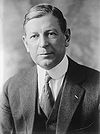
|
Dwight F. Davis (1879–1945) |
July 8, 1929 |
January 9, 1932 | |
| – | 
|
George C. Butte (1877–1940) Acting Governor-General |
January 9, 1932 |
February 29, 1932 | |
| 10 | 
|
Theodore Roosevelt Jr. (1886–1944) |
February 29, 1932 |
July 15, 1933 | |
| Franklin D. Roosevelt (1933–1945) | |||||
| 11 | 
|
Frank Murphy (1890–1949) |
July 15, 1933 |
November 14, 1935 |
High Commissioner to the Philippines (1935–42 and 1945–46)
[edit]On November 15, 1935, the Commonwealth of the Philippines was inaugurated as a transitional government to prepare the country for independence. The office of President of the Philippine Commonwealth replaced the Governor-General as the country's chief executive. The Governor-General became the High Commissioner of the Philippines with Frank Murphy, the last governor-general, as the first high commissioner. The High Commissioner exercised no executive power but rather represented the colonial power, the United States Government, in the Philippines. The high commissioner moved from Malacañang Palace to the newly built High Commissioner's Residence, now the Embassy of the United States in Manila.
After the Philippine independence on July 4, 1946, the last High Commissioner, Paul McNutt, became the first United States Ambassador to the Philippines.
| No. | Portrait | Name | Tenure start | Tenure end | President |
|---|---|---|---|---|---|
| 1 | 
|
Frank Murphy (1890–1949) |
November 14, 1935 |
December 31, 1936 |
Franklin D. Roosevelt (1933–1945) |
| – | 
|
J. Weldon Jones (1896–1982) Acting High Commissioner |
December 31, 1936 |
April 26, 1937 | |
| 2 | 
|
Paul V. McNutt (1891–1955) |
April 26, 1937 |
July 12, 1939 | |
| – | 
|
J. Weldon Jones (1896–1982) Acting High Commissioner |
July 12, 1939 |
October 28, 1939 | |
| 3 | 
|
Francis Bowes Sayre Sr. (1885–1972) |
October 28, 1939 |
October 12, 1942 | |
| 4 | 
|
Harold L. Ickes (1874–1952) |
October 12, 1942 |
September 14, 1945 | |
| Harry S. Truman (1945–1953) | |||||
| 5 | 
|
Paul V. McNutt (1891–1955) |
September 14, 1945 |
July 4, 1946 |
Japanese military governors (1942–1945)
[edit]In December 1941, the Commonwealth of the Philippines was invaded by Imperial Japan as part of World War II. The next year, the Japanese sent a military governor to control the country during the wartime period, followed by the formal establishment of the puppet Second Philippine Republic under Jose P. Laurel.[14]
On September 2, 1945, the position of Governor-General of the Philippines was abolished. The Philippines' independence from the United States was proclaimed by the Treaty of Manila on July 4, 1946, installing Manuel Roxas as the fifth President of the Philippines and ushering in the Third Philippine Republic.
| No. | Portrait | Name | Tenure start | Tenure end | Emperor |
|---|---|---|---|---|---|
| 1 | 
|
Masaharu Homma (1887–1946) |
January 3, 1942 |
June 8, 1942 |
Hirohito (1926–1989) |
| 2 | 
|
Shizuichi Tanaka (1887–1945) |
June 8, 1942 |
May 28, 1943 | |
| 3 | 
|
Shigenori Kuroda (1887–1952) |
May 28, 1943 |
September 26, 1944 | |
| 4 | 
|
Tomoyuki Yamashita (1885–1946) |
September 26, 1944 |
September 2, 1945 |
Vice-governors of the Philippines
[edit]On October 29, 1901, the position of Vice-Governor was created. The Vice-Governor was appointed by the President of the United States to act as the Governor-General (known at that time as the Civil Governor) in case of illness or temporary absence.[15]
| No. | Portrait | Name | Tenure start | Tenure end |
|---|---|---|---|---|
| 1 | 
|
Luke Edward Wright (1846–1922) [16] |
October 29, 1901 |
January 31, 1904 |
| 2 | 
|
Henry Clay Ide (1844–1921) [16] |
February 1, 1904 |
March 30, 1906 |
| 3 | 
|
William Cameron Forbes (1870–1959) [16] |
July 31, 1908 |
November 10, 1909 |
| 4 | 
|
Newton W. Gilbert (1862–1939) [16] |
February 14, 1910 |
November 30, 1913 |
| 5 | 
|
Henderson S. Martin [16] |
December 1, 1913 |
June 28, 1917 |
| 6 | 
|
Charles Yeater (1861–1943) [17] |
June 29, 1917 |
January 25, 1922 |
| 7 | 
|
Eugene Allen Gilmore (1871–1953) [18] |
January 26, 1922 |
June 20, 1930 |
| – | 
|
Nicholas Roosevelt (1893–1982) Ad interim [19] |
July 29, 1930 |
September 24, 1930 |
| 8 | 
|
George C. Butte (1877–1940) [20] |
December 31, 1930 |
June 30, 1932 |
| 9 | 
|
Joseph R. Hayden (1887–1945) [21] |
November 7, 1933 |
November 15, 1935 |
Timelines
[edit]1750–1800
[edit]
1800–1850
[edit]
1850–1898
[edit]
1898–1946
[edit]
See also
[edit]- Filipino styles and honorifics
- List of sovereign state leaders in the Philippines
- List of recorded datu in the Philippines
- President of the Philippines
- List of presidents of the Philippines
- Audiencia
- List of Viceroys of New Spain
- Spanish Empire
- History of the Philippines
- Military History of the Philippines
- United States Territory
- Governor-General
- Lists of office-holders
- Gobernadorcillo
Notes
[edit]- ^ a b c d Peterson 2007, p. 11.
- ^ a b c d David P. Barrows; The Governor-General of the Philippines under Spain and the United States; The American Historical Review Vol. 21, No. 2 (Jan. 1916), pp. 288-311 (PDF)
- ^ Halstead, Murat (1898). The Story of the Philippines and Our New Possessions, Including the Ladrones, Hawaii, Cuba and Porto Rico. p. 116.
- ^ Tucker, Spencer (2009). The Encyclopedia of the Spanish–American and Philippine–American Wars: A Political, Social, and Military History. ABC-CLIO. p. 457. ISBN 978-1-85109-951-1.
- ^ Pershing, John J. (2013). My Life Before the World War, 1860--1917: A Memoir. University Press of Kentucky. p. 547. ISBN 978-0-8131-4199-2.
- ^ a b Elliott (1917), p. 509
- ^ Elliott (1917), p. 4
- ^ Tanner (1901), p. 383
- ^ Philippine Academy of Social Sciences (1967). Philippine social sciences and humanities review. pp. 40.
- ^ Act of Congress of February 6, 1905, entitled: "An Act To amend an Act approved July first, nineteen hundred and two, entitled "An Act temporarily to provide for the administration of the affairs of civil government in the Philippine Islands, and for other purposes," and to amend an Act approved March eighth, nineteen hundred and two, entitled "An Act temporarily to provide revenue for the Philippine Islands, and for other purposes" and to amend an Act March second, nineteen hundred and three, entitled "An Act to establish a standard of value and to provide for a coinage system in the Philippine Islands," and to provide for the more efficient administration of civil government in the Philippine Islands, and for other purposes." Section 8 thereof provided that "the civil governor of the Philippine Islands shall hereafter be known as the governor-general of the Philippine Islands.
- ^ "Island – from English to Latin". Google Translate. Retrieved on August 7, 2013.
- ^ "Definitions of Insular Area Political Organizations" Archived September 25, 2012, at the Wayback Machine. U.S. Department of the Interior.
- ^ "Insular". Merriam-Webster Dictionary. Retrieved on August 7, 2013.
- ^ Cahoon (2000)
- ^ Annual Report of the War Department for the Fiscal Year Ended June 30, 1901. Washington: Government Printing Office. 1901. p. 64.
- ^ a b c d e Elliot, Charles Burke (1917). The Philippines to the End of the Commission Government: A Study in Tropical Democracy. Indianapolis: The Bobbs-Merrill Company. p. 509.
- ^ Order of Battle of the United States Land Forces in the World War (1917-1919): Zone of the Interior, Volume 3, Part 1. Washington: Government Printing Office. 1949. p. 229.
- ^ Report of the Chief of the Bureau of Insular Affairs, War Department, 1922. Washington: Government Printing Office. 1922. p. 2.
- ^ Public Papers of the Presidents of the United States: Herbert Hoover: 1930. Government Printing Office. 1976.
- ^ Annual Report of the Governor General of the Philippine Islands, 1930. Washington: Government Printing Office. 1932. p. 65.
- ^ The Michigan Alumnus, Volume XI, No. 8. 1933.
References
[edit]- Governors of the Philippines
- Cahoon, Ben (2000). "Philippines". World's Statesmen.
- Don Peterson (2007-2nd Qtr), 1898: Five Philippine Governors-General Serve Rapid Fire Terms, Philippine Philatelic Journal.
- Tanner, Dr. J.M. (1901-11). Improvement Era Vol.5 No. 1. Church of Jesus Christ of Latter-Day Saints.
- Elliott, Charles Burke (1917). The Philippines: To the End of the Commission Government, a Study in Tropical Democracy. The Bobbs-Merrill Company.
Further reading
[edit]- Barrows, David P. (1916). "The Governor General of the Philippines Under Spain and the United States". The American Historical Review. 21 (2). Oxford University Press on behalf of the American Historical Association: 288–311. doi:10.2307/1835051. JSTOR 1835051 – via Jstor.
- Barrows, D.P. (2022). A History of the Philippines. DigiCat. ISBN 978-93-5462-590-9.













